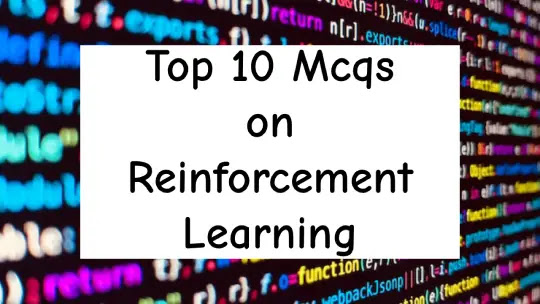Prepare to embark on an enthralling expedition into the uncharted territory of Reinforcement Learning (RL), a realm where artificial intelligence unfurls its wings and learns by daring to tread the path of trial and error. As we venture forth, we present to you a collection of ten thought-provoking multiple-choice questions, each a cryptic gateway to unraveling the enigmas of RL. Brace yourself for a cerebral adventure, as we plunge into the captivating depths of intelligent decision-making, navigating through a sea of possibilities to unlock the secrets of this dynamic domain.
1. Question: What sets Reinforcement Learning apart from other machine learning paradigms?
a) Pre-trained models
b) Supervised labeling
c) Interaction with an environment
d) Batch processing
Answer: c) Interaction with an environment
2. Question: What term describes the strategy of choosing actions to maximize cumulative rewards over time?
a) Hyperparameter tuning
b) Feature extraction
c) Reinforcement learning
d) Policy optimization
Answer: d) Policy optimization
3. Question: In Reinforcement Learning, what does the term "agent" refer to?
a) A person supervising the learning process
b) A software program making decisions
c) A labeled data point
d) A neural network architecture
Answer: b) A software program making decisions
4. Question: What are the numerical values used to evaluate the outcomes of actions taken by an agent?
a) Observations
b) Rewards
c) Policies
d) Loss functions
Answer: b) Rewards
5. Question: The "reward function" in RL is used for:
a) Defining the neural network architecture
b) Calculating the probability of actions
c) Evaluating the quality of an agent's actions
d) Filtering noisy observations
Answer: c) Evaluating the quality of an agent's actions
6. Question: Balancing between trying new actions and exploiting known actions is known as:
a) Exploration vs. exploitation
b) Model validation
c) Feature extraction
d) Dimensionality reduction
Answer: a) Exploration vs. exploitation
7. Question: Which algorithm is particularly well-suited for environments with continuous action spaces?
a) Q-Learning
b) Deep Q-Network (DQN)
c) Policy Gradient
d) Monte Carlo Tree Search (MCTS)
Answer: c) Policy Gradient
8. Question: How do Double Q-Learning and target network updates address training instabilities in deep RL?
a) By reducing the size of the neural network
b) By updating the target network more frequently
c) By using dropout regularization
d) By mitigating overestimation of action values
Answer: d) By mitigating overestimation of action values
9. Question: What challenge does sparse rewards pose in Reinforcement Learning?
a) Agents become too greedy
b) Agents stop exploring new actions
c) Agents focus only on exploitation
d) Agents struggle to learn effective strategies
Answer: b) Agents stop exploring new actions
10. Question: Which real-world applications benefit from Reinforcement Learning?
a) Image classification
b) Text generation
c) Autonomous driving
d) Data clustering
Answer: c) Autonomous driving
Bravo, RL Trailblazer! Navigating our MCQ maze, you've unraveled Reinforcement Learning's secrets. Armed with insights on exploration, rewards, and algorithms, you're poised for your RL odyssey. Keep exploring, keep mastering, and unleash intelligent decisions!




Comments
Post a Comment